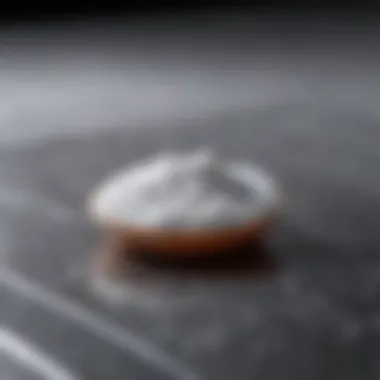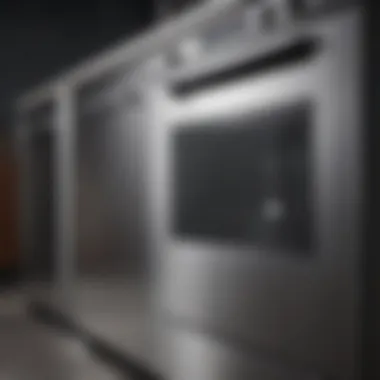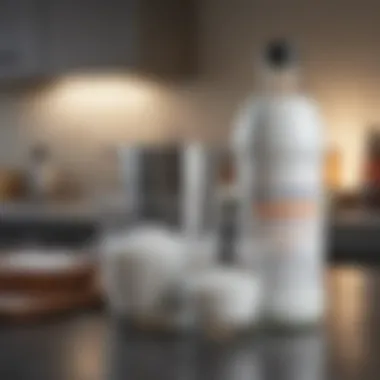Expert Tips for Cleaning Stainless Steel with Baking Soda


Intro
Stainless steel appliances have become a staple in many modern kitchens, admired for their sleek, polished appearance and striking durability. However, keeping this material in top shape can require some elbow grease. Enter baking soda, a humble household ingredient that has proven to be an excellent cleaning agent for stainless steel surfaces.
This article serves as an in-depth guide to employing baking soda effectively in your cleaning routine. Beyond its well-known role in baking, baking soda is a powerhouse when it comes to cutting through grease, grime, and tarnishes on stainless steel.
Not only will we explore why baking soda works well on stainless steel, but we will also provide practical steps to help you maintain the shiny, pristine look you desire for your appliances and fixtures. Homeowners need solutions that are both effective and safe, and this guide aims to offer clarity on how to achieve just that.
Preface to Stainless Steel Care
The allure of stainless steel in modern design cannot be overstated. Whether it’s the sleek curves of a contemporary kitchen or the intricate detail of bathroom fixtures, stainless steel conveys a sense of sophistication and durability. Yet, to maintain its luster and integrity, it requires diligent care. This article serves as your roadmap, guiding you through the subtleties of stainless steel maintenance with the time-honored remedy of baking soda.
Understanding Stainless Steel
To grasp the significance of cleaning and maintaining stainless steel, one must first dive into its composition. At its core, stainless steel is an alloy made primarily of iron, carbon, and chromium. This unique blend provides it with a shiny, rust-resistant surface. However, despite its sturdy nature, stainless steel can easily fall victim to stains, fingerprints, and scratches if left unattended.
Understanding that these materials, while robust, still need a considerate touch is imperative for any homeowner or design enthusiast. The irony is that a top-notch material like stainless steel can be marred by neglect. Thus, knowing how to properly care for it can make all the difference in keeping it looking as good as new.
Importance of Maintaining Stainless Steel
Neglected stainless steel isn’t just unsightly; it can lead to a host of issues, from surface corrosion to the development of stubborn stains that might otherwise be avoidable. Regular maintenance, therefore, isn’t just about aesthetics; it extends the life of the material, saving you the expense of premature replacement.
- Enhances Aesthetic Appeal: Nothing shouts "clean" quite like a well-maintained stainless steel surface, adding a layer of glamour to any room.
- Prevents Damage: Routine cleaning can combat oxidation and rust, preserving the integrity of your appliances and fixtures.
- Simplifies Cleaning: The less built-up grime there is, the easier it is to manage in the future.
Put simply, consistent attention to stainless steel care will reward you in spades. Invest a little time now, and you could avert much larger headaches later on. Take it from those who've learned the hard way—there's a lot of wisdom in preserving what shines.
Why Choose Baking Soda for Cleaning?
Baking soda has earned a reputation as a household miracle worker, and it’s easy to see why it features prominently in cleaning routines, particularly for stainless steel. This section discusses why baking soda stands out as a cleaning choice, revealing its effectiveness, versatility, and cost-efficiency.
Chemical Properties of Baking Soda
Baking soda, or sodium bicarbonate, is a white crystalline powder with a somewhat alkaline nature. This is the key to its cleaning prowess. The mildly abrasive texture of baking soda allows it to gently scrub away dirt and grime without scratching stainless steel surfaces. When mixed with water, it forms a paste that can adhere to surfaces long enough to penetrate stains and stubborn residues.
Moreover, baking soda has neutralizing properties. This means it can counteract acidic substances, which is particularly useful when dealing with tough stains like vinegar or juice spills. This dual-action—cleaning through abrasion and neutralizing—makes it an ideal contender against various types of stains.
- Non-Toxic: Unlike many commercial cleaners, baking soda doesn’t contain harsh chemicals. It's safe for both human contact and the environment, which makes it a great choice for homes with children and pets.
- Deodorizing Action: Beyond just cutting through grease, baking soda is known for its ability to absorb odors, making it perfect for use in kitchens.
Baking Soda Versus Commercial Cleaners
When choosing a cleaning agent, one might be tempted to reach for popular commercial cleaners, dazzled by their shiny packaging and promises of spotless surfaces. However, a closer inspection reveals that baking soda offers several advantages that set it apart from its commercial counterparts:
- Cost-Effectiveness: Baking soda is considerably cheaper than many branded cleaners. A small box can last for months, making it a budget-friendly solution for maintaining your stainless steel.
- Safety: Many commercial cleaners contain harsh chemicals that can cause skin irritation or respiratory issues when inhaled. In contrast, baking soda is a benign household staple, presenting no such risks.
- Environmentally Friendly: The environmental impact of our cleaning choices is becoming increasingly significant. Baking soda is biodegradable and contributes to less plastic waste when compared to commercial products that often come in non-recyclable containers.
- Multipurpose Use: While commercial cleaners often target specific surfaces, baking soda is versatile. It can be used effectively on various materials—including glass, fabric, and tile—making it a one-stop-shop for many cleaning tasks.
By weighing these considerations, one can see baking soda isn’t just another cleaning agent; it’s a smart choice that meets many needs without compromising safety or effectiveness.


Preparation Before Cleaning
Before embarking on the journey of cleaning stainless steel surfaces, it's essential to lay the groundwork. Preparation is often the unsung hero in any cleaning endeavor. Taking a few moments to prepare can save time and ensure the process runs smoothly. This phase involves gathering the right supplies, assessing the state of your stainless steel items, and understanding the best approaches for effective cleaning.
Effective preparation ensures that you have everything at your fingertips. A well-stocked supply list avoids the dreaded mid-cleaning scramble for missing items, which can lead to frustration. Moreover, knowing the condition of your stainless steel prior to cleaning helps you determine the right techniques to apply. This way, you tackle each cleaning job mindfully, avoiding potential damage to the surface. Overall, proper preparation can enhance the effectiveness of baking soda and yield stellar results.
Gathering Necessary Supplies
The first step in preparing for your cleaning task is to gather all necessary supplies. While baking soda takes the spotlight, a few other tools can make the job even easier.
- Baking Soda: The centerpiece of this cleaning method, known for its gentle abrasive qualities.
- Soft Cloths or Sponges: These are critical for applying your baking soda paste without scratching the surface. Microfiber cloths work particularly well.
- Warm Water: Helps to dissolve any remnants and makes it easier to remove grime.
- Spray Bottle: To mix water with baking soda effortlessly; this can also help in applying solutions.
- Bucket: For rinsing and larger jobs where multiple surfaces need attention.
Having these items on hand means you're not scrambling last minute and instead can channel your focus into producing sparkling results.
Assessing the Condition of Stainless Steel
Taking a careful look at your stainless steel can yield insights that shape your cleaning strategy. Different surfaces may have varying levels of grime, staining, or even scratches. Before diving into the cleaning process, ask yourself some questions:
- How dirty is the surface? Light spots may require a more gentle touch, while heavy build-up can stand up to a more assertive cleaning method.
- Are there scratches or dents? This will determine how much elbow grease you’ll want to apply, as you don’t want to exacerbate existing issues.
- Is this surface in a high-traffic area or exposed to elements? This affects the type of stains or residues you might need to focus on—the grease from a kitchen compared to a lightly used bathroom fixture can vary dramatically.
By evaluating the condition of your stainless steel, you effectively prepare your approach, tailoring your cleaning method to suit the specific situation.
Taking these necessary preparation steps not only boosts your cleaning efficacy but also protects the integrity of your stainless steel items.
Step-by-Step Cleaning Process
Cleaning stainless steel with baking soda is not just a basic chore; it’s an essential task that can significantly extend the lifespan and shine of your metal surfaces. Integrating a meticulous cleaning strategy will not only enhance the aesthetics of your appliances and cookware but also provide a protective barrier against dirt and stains. Each step plays a pivotal role in ensuring that the cleaning is effective and thorough.
Making the Baking Soda Paste
Creating a baking soda paste is simplicity itself, but this mixture is foundational for the entire cleaning operation. To make the paste, you generally combine three parts of baking soda with one part water, adjusting the consistency to what you feel is most effective. Some folks prefer a little thicker mix while others like it more fluid. The paste should stick well to surfaces but be easy to spread. The mild abrasiveness of baking soda helps lift grime without scratching the stainless steel surface, which is a key consideration when cleaning finer appliances or fixtures.
Applying the Paste
The way you apply the paste can make a world of difference in your cleaning result. Broad strokes or focused applications might be asked, based on how grimy the surface in question might be. To achieve optimal results, there are a couple of methods you can use.
Using a Soft Cloth
When it comes to cleaning delicate stainless steel surfaces, using a soft cloth is a game changer. A fluffy microfiber cloth not only prevents any likelihood of scratches but also holds onto the baking soda paste efficiently. The plush material gets into crevices that rough sponges might miss - and let's be honest, who wants to mar that sleek finish? The key characteristic of this method is gentleness combined with effectiveness.
The soft cloth is a cozy partner to the baking soda, ensuring even distribution and preventing any abrasive damage. However, it does have its drawbacks. If too much pressure is applied, even the softest cloth can leave fibers behind, which might require an additional wipe down.
Focusing on Stains and Spots
Spot treatment is another crucial aspect when applying the baking soda paste. Stains often have a grip that general cleaning might overlook. By targeting spots, you can give embedded stains the focused attention they need. The characteristic focus allows you to utilize the baking soda’s natural grit in a more strategic way, working it directly into those areas of concern.


This method is beneficial, especially in kitchens where grease and food residue build up. The unique aspect here is allowing the paste to sit on tough stains for a minute before wiping, to let it do its work. However, be cautious not to leave it too long, as this can potentially cake and complicate the rinsing step.
Rinsing and Drying
Once you have scrubbed with the baking soda mixture, the next step involves rinsing and drying—don’t skip it. Skipping these steps could lead to dullness or a faded look. Getting the paste off completely ensures that no residue lingers, which might attract dirt or cause streaking over time.
Importance of Thorough Rinsing
Thorough rinsing is essential in this cleaning regimen. Leaving any baking soda behind could prevent that sparkling finish we seek when maintaining stainless steel. The key characteristic of proper rinsing is ensuring that all cleaning agents, along with grime, are entirely removed. This can prevent the steel from deteriorating in the long run. Water alone often suffices here, making the process easy and accessible.
Failing to rinse effectively might not only leave marks but could also lead to a tacky surface that feels unclean. You wouldn’t want your hard work to go in vain, so running that cloth or sponge under warm water and thoroughly washing down every part is pivotal.
Proper Drying Techniques
Once rinsing is complete, proper drying techniques must be followed for that picture-perfect shine. Using a clean, dry cloth is insufficient; the approach can impact the final look. The drying process should be gentle yet thorough.
Wiping in the direction of the steel grain matters. Doing this not only keeps scratching to a minimum but also promotes a uniform appearance, one that catches the eye effortlessly. An often overlooked but beneficial technique is using a dedicated drying cloth that’s lint-free; this promotes a polished look without leave residues.
Neglecting proper drying can result in water spots or streaks which defeat your entire cleaning efforts—nobody wants that! Overall, these steps together create a foolproof method enhancing your stainless steel’s shine and durability.
Addressing Common Stains and Challenges
Cleaning stainless steel is not just about achieving a shine; it’s about tackling the various types of stains and marks that can occur over time. Every surface, whether on a kitchen appliance or a sink, can face unique challenges depending on its environment and usage. Understanding how to address these common stains is essential not just for aesthetic reasons but also for the longevity of the surface. When you keep your stainless steel pristine, it adds to the overall elegance of your home. Additionally, regularly addressing these challenges means you won’t be left grappling with tougher clean-up jobs later on.
Removing Hard Water Stains
Hard water stains are a well-known nuisance in many households, especially in areas with high mineral content in their water supply. These stains can appear as cloudy spots or streaks on your stainless steel surfaces, detracting from their natural luster. Fortunately, baking soda shines in handling these stains due to its mildly abrasive nature and ability to break down mineral deposits efficiently.
To tackle hard water stains, start by mixing a solution of baking soda and water to create a paste. Apply the paste directly to the affected areas and let it sit for several minutes. This step allows the baking soda to work its magic. After some time, use a soft cloth to scrub gently. You’ll notice that the stains start to lift. Rinse thoroughly with water to prevent any residue, as this may lead to further staining and dullness.
- Pros of using baking soda:
- Non-toxic and safe to use.
- Economical compared to commercial cleaners.
- Mildly abrasive, which enhances its effectiveness.
Dealing with Rust Marks
Rust marks can be particularly troubling on stainless steel surfaces, often arising when moisture is trapped or when there’s damage to the protective layer. These unsightly spots not only diminish the beauty of stainless steel but can hampering its structural integrity if left untreated.
To treat rust marks, first, prepare a paste of baking soda and water. Apply this mixture directly onto the rust spots, allowing it to sit for approximately 30 minutes. Then, scrub with a soft cloth or a non-abrasive sponge in circular motions. It’s important to ensure that you’re not over-scrubbing, as this may scratch the surface. After cleaning, rinse off the area completely, ensuring no baking soda residue lingers. If rust remains stubborn, repeating the process might be necessary; persistence is key.
Cleaning Greasy Residue
Stainless steel surfaces, especially in kitchens, often battle grease. Whether it’s from cooking or simply handling utensils, greasy residue tends to cling to the surfaces. Baking soda is particularly adept at dismantling this greasy grime, providing a straightforward solution for homeowners.
Start by sprinkling a generous amount of baking soda onto the greasy area. Then, take a damp cloth—perhaps even a microfiber one since it’s effective for such jobs—and begin to wipe. The combination of the cloth's texture and baking soda's mild abrasiveness will help lift away the grime. In case the grease is extensive, you can add a few drops of dish soap into the equation to supercharge your cleaning. After the grease is removed, be sure to rinse thoroughly to leave no residue behind.


Preventive Measures for Maintaining Stainless Steel
When it comes to keeping stainless steel looking sleek and shiny, prevention is the name of the game. Regular upkeep can save you from abrasive scrubbing down the line. Like an old saying goes, "An ounce of prevention is worth a pound of cure." It's definitely true here, as the longer you leave stains or dust to settle, the tougher it'll be to get rid of it later.
Routine Cleaning Practices
Implementing a routine cleaning practice isn’t just about keeping up appearances; it’s about protecting your investment. A simple wipe down with a damp cloth after cooking or using appliances goes a long way in preventing buildup. Consider this: every crumb or grease particle left behind can eventually lead to stubborn stains and tarnishing.
Here's how to keep at it:
- Daily Wipe-Downs: Just a quick once-over with a soft, damp cloth after cooking can keep larger messes at bay.
- Weekly Clean: Set aside a day, maybe Sunday, to do a more thorough clean. Use that baking soda paste as a preventive measure, especially in frequently used areas.
- Observe and React: If you notice any signs of water spots or fingerprints, address them quickly. The sooner you tackle them, the less scrubbing will be needed later.
Avoiding Harsh Chemicals
One crucial aspect of maintaining stainless steel is steering clear of harsh chemicals. Sure, the allure of super-cleaning agents might sound appealing, but many of them can do more harm than good. They may strip the surface of its natural shine or even cause corrosion in the long run.
Consider opting instead for natural alternatives like baking soda. Not only is it gentler, but it’s also better for the environment.
Some points to keep in mind:
- pH Balance: Stick to pH-neutral cleaners. Acidic or alkaline substances can etch or degrade the stainless steel's surface.
- Always Test First: If you’re unsure about a product, apply it to a less visible area first to see how it reacts.
- Read Labels Carefully: When choosing cleaners, look for those specifically labeled safe for stainless steel surfaces. You want to play it safe here.
Utilizing Protective Coatings
A proactive approach is often the best defense. Applying a protective coating can be likened to putting a raincoat on—a small step that makes a significant difference. It helps create a barrier against dirt, grime, and unnecessary wear and tear.
Options include:
- Waxing: Applying a food-safe wax can give surfaces a protective layer, minimizing fingerprints and smudges. Reapply every few months for optimal results.
- Commercial Sealants: These are designed for stainless steel specifically, providing a long-lasting protective finish. Ensure you choose a reputable brand to avoid any adverse effects.
By adhering to these preventive measures, homeowners can significantly enhance the longevity and appearance of their stainless steel surfaces. Investing a little effort into routine cleaning, avoiding harmful chemicals, and using protective coatings pays dividends in how stainless steel appliances and fixtures look and perform.
"The secret to beautiful stainless steel is not just about cleaning; it's about caring for it every day."
It’s not just about aesthetics; it’s about appreciating the beauty of what you have. Following these steps helps in ensuring that your stainless steel continues to shine bright like a diamond.
Ending
Cleaning stainless steel with baking soda is more than just a simple chore; it's a significant part of maintaining modern aesthetic and functionality in our homes. The approach discussed throughout this guide equips homeowners and design enthusiasts with a practical method to preserve the shiny allure of stainless steel surfaces, like appliances and fixtures. By utilizing baking soda, a non-toxic and accessible cleaning agent, individuals can ensure that these surfaces not only look good but remain durable over time.
Final Thoughts on Using Baking Soda
In the realm of cleaning, baking soda stands out as a powerhouse ingredient. Its gentle abrasive nature allows it to scrub away stubborn stains without scratching the surface, making it an ideal choice for delicate stainless steel. Not only is it effective, but it's also safe for the environment and can save one a few bucks compared to expensive commercial cleaners. Moreover, it shows versatility, being handy in various other cleaning tasks beyond stainless steel. As more folks turn toward sustainable living, incorporating baking soda into the cleaning repertoire is a smart move.
The Lasting Benefits of Proper Care
Taking care of stainless steel surfaces doesn't just prolong their lifespan; it enhances the overall ambiance of a home. A well-maintained stainless steel appliance blends seamlessly into diverse interior designs, from modern minimalist to luxurious industrial styles. Regular cleaning with baking soda means less buildup of grime, which simplifies subsequent cleaning activities and keeps surfaces looking fresh.
In summary, adopting a routine of cleaning with baking soda will yield satisfying results that stand the test of time and delight the eyes, cementing its place as an essential practice in home care.
"An ounce of prevention is worth a pound of cure." By making a small effort now, the future benefits—both aesthetic and practical—are immeasurable.







